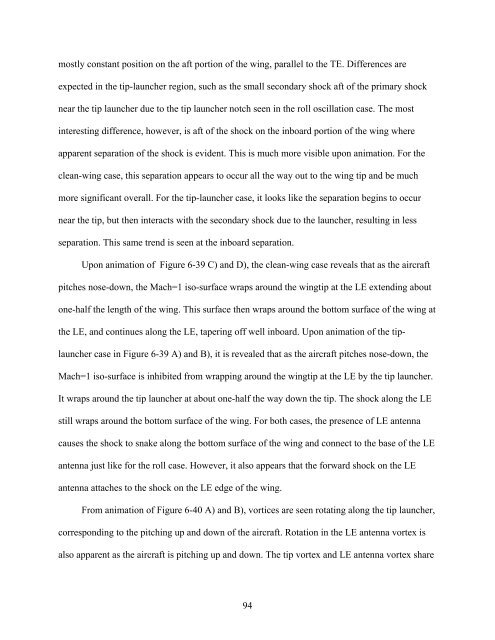university of florida thesis or dissertation formatting template
university of florida thesis or dissertation formatting template
university of florida thesis or dissertation formatting template
You also want an ePaper? Increase the reach of your titles
YUMPU automatically turns print PDFs into web optimized ePapers that Google loves.
mostly constant position on the aft p<strong>or</strong>tion <strong>of</strong> the wing, parallel to the TE. Differences are<br />
expected in the tip-launcher region, such as the small secondary shock aft <strong>of</strong> the primary shock<br />
near the tip launcher due to the tip launcher notch seen in the roll oscillation case. The most<br />
interesting difference, however, is aft <strong>of</strong> the shock on the inboard p<strong>or</strong>tion <strong>of</strong> the wing where<br />
apparent separation <strong>of</strong> the shock is evident. This is much m<strong>or</strong>e visible upon animation. F<strong>or</strong> the<br />
clean-wing case, this separation appears to occur all the way out to the wing tip and be much<br />
m<strong>or</strong>e significant overall. F<strong>or</strong> the tip-launcher case, it looks like the separation begins to occur<br />
near the tip, but then interacts with the secondary shock due to the launcher, resulting in less<br />
separation. This same trend is seen at the inboard separation.<br />
Upon animation <strong>of</strong> Figure 6-39 C) and D), the clean-wing case reveals that as the aircraft<br />
pitches nose-down, the Mach=1 iso-surface wraps around the wingtip at the LE extending about<br />
one-half the length <strong>of</strong> the wing. This surface then wraps around the bottom surface <strong>of</strong> the wing at<br />
the LE, and continues along the LE, tapering <strong>of</strong>f well inboard. Upon animation <strong>of</strong> the tip-<br />
launcher case in Figure 6-39 A) and B), it is revealed that as the aircraft pitches nose-down, the<br />
Mach=1 iso-surface is inhibited from wrapping around the wingtip at the LE by the tip launcher.<br />
It wraps around the tip launcher at about one-half the way down the tip. The shock along the LE<br />
still wraps around the bottom surface <strong>of</strong> the wing. F<strong>or</strong> both cases, the presence <strong>of</strong> LE antenna<br />
causes the shock to snake along the bottom surface <strong>of</strong> the wing and connect to the base <strong>of</strong> the LE<br />
antenna just like f<strong>or</strong> the roll case. However, it also appears that the f<strong>or</strong>ward shock on the LE<br />
antenna attaches to the shock on the LE edge <strong>of</strong> the wing.<br />
From animation <strong>of</strong> Figure 6-40 A) and B), v<strong>or</strong>tices are seen rotating along the tip launcher,<br />
c<strong>or</strong>responding to the pitching up and down <strong>of</strong> the aircraft. Rotation in the LE antenna v<strong>or</strong>tex is<br />
also apparent as the aircraft is pitching up and down. The tip v<strong>or</strong>tex and LE antenna v<strong>or</strong>tex share<br />
94
















